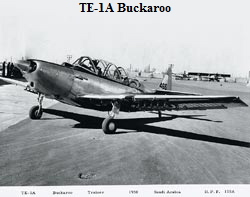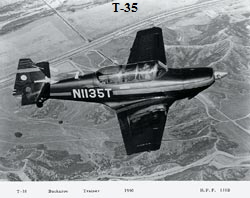|
January
As a result of Globe’s bankruptcy, the year began on a somber note. Personnel was reduced to the minimum with just enough to continue the profitable Fairchild Aircraft and popcorn machine programs. Temco was at the very brink of bankruptcy.
“It was tough trying to operate in those days” a materials man remembered. “All our supplies were shipped COD, so we worked on a day-by-day basis. Every day we’d ask production how much material they’d need for the next day’s operation. Then we’d draw a check for that amount and go to the freight yard to pick it up.” Metal scrap barrels were combed for usable material, and a payroll was me in January by selling all inactive lead and Kirksite dies the company owned to a salvage yard.
To save the day, Bob McCulloch and Bert Howard were able to convince creditors that the Company could pay off its debts only by staying in business. The accounts payable creditors (with only one exception) agreed to accept extended monthly payments to satisfy those accounts. The bank agreed to accept debt payments in installments as well as provide an additional loan. Preferred and common stock shares were also sold to provide funds to purchase the unencumbered assets of the bankrupt Globe Aircraft Corporation.
April
(April) Over 100 multi-motor planes are awaiting overhaul or conversion work at Temco. This represented a backlog of more than four million dollars in business. There were B-25’s, C-47’s, C-54’s, and Beechcrafts being worked. Some of the larger planes, such as the C-54’s and C-47’s were receiving complete interiors as are found in standard airliners. Thanks to the large working areas available in the Grand Prairie plant, Temco is able to work on the largest aircraft built. The original order for the manufacture of 14,000 popcorn machines has now been increased to 20,000. More than 10.000 had been completed by April of this year. Temco held its first stock-holder meeting on April first of this year. It was announced that $1,180,000 of the $1,800,000 obligation incurred five months before had been liquidated.
Temco obtains CAA approval to manufacture four different styles of aircraft passenger reclining-type seats. The company manufactured these seats in large quantities not only to install in aircraft being converted, also for sale to large commercial airlines for their aircraft fleet. A unique hydraulic valve designed by Temco employees was used on the various style seats. The valve weighs less than six ounces and is considered to be superior to most types found in other aircraft seats. Orrin Berthiaume, Superintendent, and Paris F. Young were directly responsible for the design and manufacture of this valve. The last plane for the F-24 contract with Fairchild Corporation was delivered in this month.
August 1947
The company established a Sales and Service organization for marketing the recently acquired Swift airplane. The manufacturing procedures for building were not new to Temco, since originally the company had a contract with the former Globe Aircraft Corporation of Fort Worth to manufacture 1500 of these two-seat private planes for Globe. The company purchased patent and manufacturing rights from the bankrupt Globe along with tools, raw materials, supplies, and subassemblies. Temco was able to reduce the price on the Swift airplane, since Globe had spent more than $20,000,000 in developing the Swift.
December
A contract between Temco and the U. S Navy was consummated for a five-year lease of Plant “A” of the huge government-owned industrial facility in Grand Prairie and a one-year lease for the maintenance and protection of both Plants “A” and ”B”. The contracts are retroactive to December 1, 1947 when the Navy assumed ownership of the properties formerly owned by the Reconstruction Finance Corporation (RFC) and operated by North American during the war years. Temco has occupied more than 500,000 square feet of the 1,229,500 square feet of Plant “A” for the previous two years. The one-year maintenance and protection lease for Plant “B” is subject to a 30-day cancellation clause. This arrangement leaves it open for the Navy to reach an agreement with two eastern aircraft companies for eventual occupancy of plant “B”. Negotiations are underway with Chance Vought for removal of its entire facilities from Stratford, Connecticut, and with Glen L. Martin of Baltimore, Md. for the establishment of a facility in Plant “B”. Twenty six other tenants occupied the properties at this time with Temco. Plant “A” was started in 1940 and completed in early 1941. Plant “B” was started in early 1942 and completed late in the same year. Temco also shared the use of adjoining Hensley Field, owned by the City of Dallas and under lease to the Navy and the Army, through a lease agreement. In the two years of its existence, Temco had become a major national factor in the overhaul and modification of military aircraft for the Army Air Force and the conversion of transports for domestic and foreign airlines.
Foreign governments and airlines have recently placed orders more than $500,000 worth of airplanes and spare parts, President Robert McCulloch announced. Orient Airlines of Calcutta, India ordered four C-47’s converted into 21-passenger airliners. Three B-25 bombers will be delivered before January 1st to the Venezuelan government. The Brazilian government has contracted for complete reconditioning of a large number of B-25, P-47, and P-40 spare parts, which they purchased from surplus. The company is also working on a substantial supply of aircraft parts for Venezuela.
By December 1947 the bank debt of $808,000 had been completely paid off. Accounts Payable had been reduced from $875,500 to $101,000.
 The TE-1A Buckaroo Military Primary Trainer was Temco’s first effort at designing and producing an aircraft for military use. Development of the Buckaroo represented a new emphasis on engineering. It indicated the company’s growing interest in the design of complete aircraft and its rediness to undertake military development work at its own expense. A limited quantity of these trainers was produced and delivered to the Saudi Arabian Air Force in 1948. An improved version of the aircraft was subsequently sold to the U. S. Air Force The TE-1A Buckaroo Military Primary Trainer was Temco’s first effort at designing and producing an aircraft for military use. Development of the Buckaroo represented a new emphasis on engineering. It indicated the company’s growing interest in the design of complete aircraft and its rediness to undertake military development work at its own expense. A limited quantity of these trainers was produced and delivered to the Saudi Arabian Air Force in 1948. An improved version of the aircraft was subsequently sold to the U. S. Air Force  for evaluation. Later the designati on was changed to T-35, and in 1951, competed with Beech’s T-34 at Goodfellow Air Force Base for acceptance as the next generation basic trainer for the Air Force. After an extended evaluation period, Beech was declared the winner. The Buckaroo was making its demonstration debut abroad when hostilities began in Korea. Temco sidelined all Buckaroo activities to devote full attention to subcontract work on first-line combat aircraft. for evaluation. Later the designati on was changed to T-35, and in 1951, competed with Beech’s T-34 at Goodfellow Air Force Base for acceptance as the next generation basic trainer for the Air Force. After an extended evaluation period, Beech was declared the winner. The Buckaroo was making its demonstration debut abroad when hostilities began in Korea. Temco sidelined all Buckaroo activities to devote full attention to subcontract work on first-line combat aircraft.
The company continued to solicit general product manufacturing business during 1948, and a contract to assemble 2,000 farm tractors was acquired. But general products were beginning to appear out of place in a plant that had become associated around the world with aircraft know-how.
|